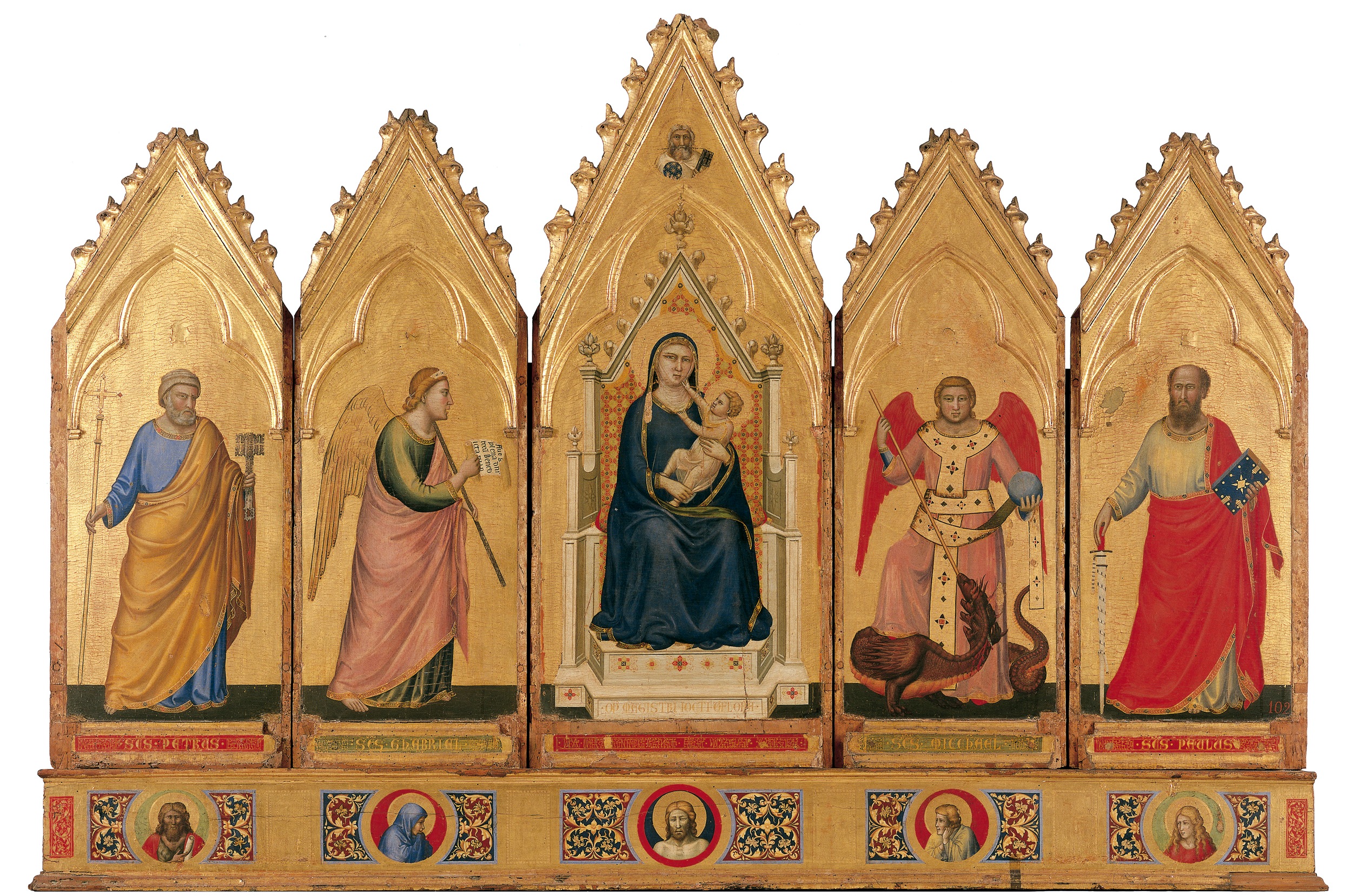
source file
Giotto
John Bjarne Grover
Article on Giotto (1267-1337).
1. Giotto's "Polittico di Bologna" = 'Polyptych of Bologna' (appr. 1330)
seems to find an interpretation in the opening poem (TEQ #606) - the beginning of which was written in the early morning 1 january 2000 - of the tenth book 'A deep ratch' - in the third quarter 'A saga Hume' - of my 16-volume 'The Endmorgan Quartet':
The artwork has suffered 'a deep ratch' in the course of the 700 years since it was made - if this is not painted in by Giotto, which I suppose it is not:
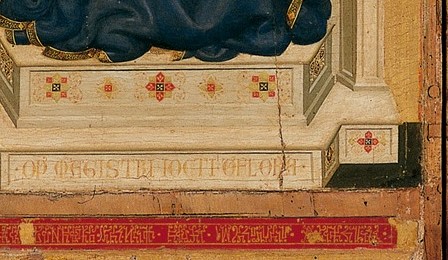
The 'deep ratch' - see the detail
The text (which has suffered the 'ratch') at the foot of the Madonna in the middle is (by the article) "OP[US] MAGISTRI IOCTI D[E] FLOR[ENTI]A". This 'Jocti' is probably, tells the Fratelli Fabbri edition, a name of a skilled person in the workshop of Giotto - but there could be a play with 'joke' or 'yoke' in the latin form - by which 'OPUS' could refer to St.Peter with the big key to the left, for 'open [the] house', the magister is the Gabriel with the text, the YOKE is Michael with the 'yoke' for the worm, and the 'de Florentina' would be Paulus with the flower-like emblems on the cover to the book. However, the text is largely abbreviated and one could see in this a reference to the OPS, which in latin means the goddess of earth and fertility, hence a certain 'pre-christian' classic-mythological epithet to the Madonna. Hence also the 'Achaian' greek reference to the worm of Michael.
This is why the name 'FLORentinA' has suffered a slit or ratch in historic time and thereby transforms to a FLORA of the goddess of earth and fertility - see Tiepolo's "Triumph of Flora" (source) - the ratch has gone through the latin ENS = 'being'.
However, like the goddess OPS of earth and fertility:
Ancient greek OPS = ωψ with long O = sight, eye (seeing the artwork)
Ancient greek OPS = οψ with short O = voice, word (hearing the speech - here 'the (inner?) poetic revelation')
Hence the deep ratch in the artwork runs through the ENTI = 'being' which here links from the vision to the inner poetic articulation. It tells that the inner poetic-divine revelation tells the deep ratch in the timber board that holds the artwork.
The FLORA is seen in the flower decorations on the top edge of the throne - with this OP-reference to the historic deep ratch that has run through the wooden timber below.
The first stanza in the poem tells the same as Bassano's 'Flight to Egypt' (source) - see also these comments on Bassano relative to my TEQ - it is seen that the veil that 'ghostly' surrounds the head of Mary seems to contain 'nail'-like elements, as shown clearly in this scan from the Fratelli Fabbri reproduction, while the ground contains a flower under the foot of the donkey.
In this detail of Giotto, though, is seen the same Jesus' right hand reaching for her 'veil', while he 'pities' the brim of her coat out with his left hand - the 'nail ground so ghostly manteled' is then seen at the foot part where there is a corresponding fold. 'To make things tablets' could refer to the two flanking wooden parts on the chair or throne, displaying the central perspective which was under development just under the time of Giotto, and recognizing these in the round glories that surround the Madonna and the Jesus child. Her glory exhibits a 'train' of some symbols, his shows another form which then probably is about a naming function, could be associating with the background pattern.
Would this mean that the breach or 'deep ratch' in the timber of the artwork basis is opening up for the ENTE = 'being' of the divine revelation given birth in the visual observation of the artwork? Then it is interesting indeed to compare with the 'timberleave' of Parmigianino's 'Pala di Bardi' - in particular in view of the restoration it was subjected to in 2016-18 which seems to have removed just this piece of timber from the artwork being tempera on timber wood - that is notable in comparison not only with the title of my TEQ #1594 which can be read as a description of certain important aspects of this artwork. However, an even more interesting observation is the fact that the line drawings of Catherine's dress in this 1521 artwork of Parmigianino are very similar to the line drawings on the 1531 divine revelation of the Madonna of Guadalupe in Mexico - sufficiently similar to hypothesize a direct connection contained in the 10 years interval: It means that the artwork of Parmigianino with its 'timber' running through the artwork in the lower righthand part 'gave birth to' the Madonna of Guadalupe in the same way as Giotto's 1330 artwork gave rise to a 'deep ratch' running through the timber in the same lower righthand part of the artwork.
"...but I've also said something / that's over 60 year": This 'rate of change of acceleration' points to the Word becoming flesh - and hence being the ENTE = 'being' that is the converse of the seeing and hearing in the breach of the deep ratch - notice the 'ratch' in the sense of a 'ratched wheel' in the clock driven by gravity - resembling the 'clock' of Parmigianino.
The hebrew parallel text to TEQ #606 is Exodus 17:1 = ויסעו כל- עדת בני- ישראל ממדבר- סין למסעיהם על- פי יהוה ויחנו ברפידים ואין מים לשתת העם
Exodus 17:1: And set out all the congregation of the sons of Israel from the Wilderness of Sin on their journey according to the commandment of Yahweh and camped in Rephidim but no [there was] water to drink for the people
to pull out/up, set out = and they set out
1) the wilderness, 2) the mouth
sin = clay, dirt, mud?
= from the mouth of dirt
pulling up, breaking (camp) for journey
= on their journey
up, above, over
= according to
commandment = mouth
= the mouth of Yahweh
to camp = to decline, bend down, encamp
raphad = to spread
= and bent down to spread out
but there was not water for the people
= and they went from pulling up the mouth of dirt/earth to pulling up the mouth of Yahweh, and bent down to spread (it) out - and there was not water for the people
Hence the hebrew could suggest that - in Giotto's polyptych - St.Peter with the big key to the left is for 'open [the] house' while the yoke-spear of the angel Michael tells (to the Achaian worm) 'open the mouth' - this being transferred to opening the mouth of Yahweh by opening the holy book of St.Paul which contains the words of the angel Gabriel - which is to bend down and spread it out (the book, the text by the OPS = vision) which is the cause of the opening of 'A deep ratch' running through the Madonna and Jesus part in the middle, in the lower righthand side - telling the word of the OPS = voice. As such, there is a similarity not only with my poem but also with Parmigianino's 1521 theme - which could be seen as related to the revelation of the Madonna of Guadalupe 10 years later, in 1531. What happened 10 years after Giotto had completed this artwork in probably 1330? This page suggests that John of Nepomuk could have been born around that time of 1340 - he became a saint by his martyrium when he was thrown into the river Vltava of Prague in 1393. (In fact just next to the university where there was some terror some 25 days ago - this story could be suggestive of the phenomenon that such terror (if it be organized for 'security' reasons) seems not to be arrested by the authorites - could be because 'it looks/hears right[hand side]').
The 'Achaian': It is seen that the 'doorstep to Achaea' would be about Peloponnese at the strait between Antirrio and Rio Pio - connected with the 'Charilaos Trikoupis' - cp. the 'Charles Bridge' where John of Nepomuk was martyred in 1393. Cp. the idea of 'peace' have become windup-like - after the restoration of the Parmigianino artwork?
At the university shooting in Prague the people inside the building were not asked to 'walk the plank', but maybe some of them had to 'walk the mural' - as the article tells: "Several of those inside fled the building by jumping onto a rooftop terrace from the exterior ledges".
Restorations of the old masters is not safe. When advanced technology can extract the coffein from the coffee beans, it is only a matter of time when chemistry will be able to pull out the dirt from the art by some gas that pulls the dirt and carbons out. What will happen now after Michelangelo has been 'restored' (= his brush strokes wiped away) in the ceiling of the Sistine Chapel in the Vatican? Of course there probably cannot be a causal relation - but there could seem to be a semiotic relation of some sort. And indeed it could seem that art matters.
The black plague started in 1346 - it claimed about half of Europe's population.
What happened 10 years after my TEQ was completed in 2008? It was not published in 2008 but withheld (no publication interests came up) and I fell ill from retention = 'withhold' crisis in late 2018. One year after that again COVID broke out.
In fact the converse of this artistic sensory impression of vision and voice can be seen to be found in the mirror poem to TEQ #606 - which is TEQ #1114 and tells of the 'praxis':
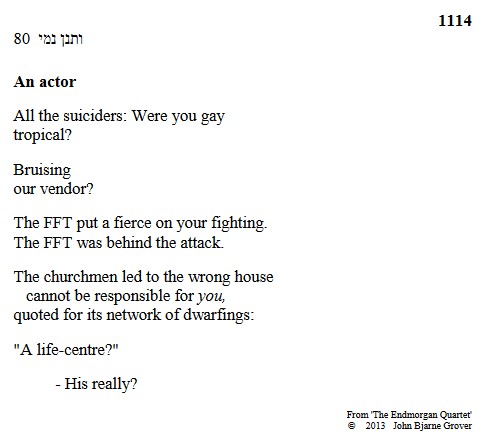
(FFT = Fast Fourier Transform which computes the relation between time and frequency in a spectrum - see volume 4 chapter 5)
This seems to tell the 'converse' - not the inner poetic articulation from a vision but the 'being' that became visible in the opening slit in the timber of the artwork.
The hebrew to TEQ #1114:
ותנן
= 1) to stiffen, 2) to smoke, to smoulder, to fumigate.
נמי
= at all events, really, even, likewise.
Quite interesting - this morning 14 january 2024 a new volcanic eruption took place just outside Grindavik in Iceland - the lava is coming through 'deep slits' and is spreading over the landscape and is probably going to reach the town in the course of a few hours - here is the situation in this moment of writing (source https://www.visir.is - see also directly from the scene by Morgunbladid). I wrote most of the above in the morning yesterday 13 january - in the evening earthquakes started at Grindavik and in the morning today I wrote out most of the rest of the above - and the volcano erupted through 'a deep ratch' at 07:57 UTC.
2. Giotto "Presentation of Jesus" at the temple (source):
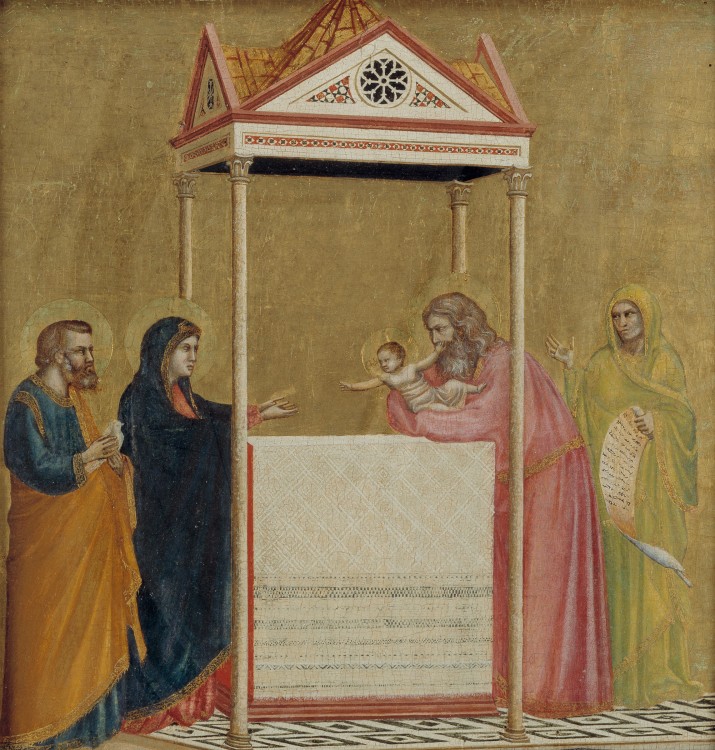
can be seen to find an interpretation TEQ #885:
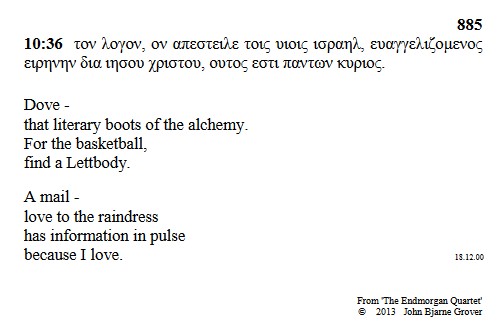
An alternative but similar version (source).
The mirror poem to this is TEQ #835:

17 january 2024: It is seen that Giotto's "Presentation of Jesus" at the temple constitutes a counterpoint to the egyptian
sunflower matrix - see this illustration from the tomb of Senbi - the baldachin serves the function of delimiting the sunflower matrix with the Jesus child as the 'Senbi' or 'Moses' - depends on the transform this way or that. As seen from the more specialized discussion in this article, this sunflower matrix seen in the larger context of the tomb wall invokes the concept of a theory for computation beyond the Turing boundary. This phenomenon is mentioned in this brief article from which it can be conjectured that such computation beyond the level of symbolic manipulation a la the Turing definition can be recognized as residing inside the intersection of the transform of harmony and counterpoint, synchrony and diachrony, paradigm and syntagm etc. Interestingly, it can be conjectured that this 'field of intersection' is precisely what my TEQ #835 is about - the mirror poem to TEQ #885. 'But it was convertible' is that intersecting 'sunflower matrix'. The 'Balanshid' would be the long spear of 'Moses'. The 'E-mail Jason' is found in the following phenomenon discussed in the articles on the sunflower matrix etc:
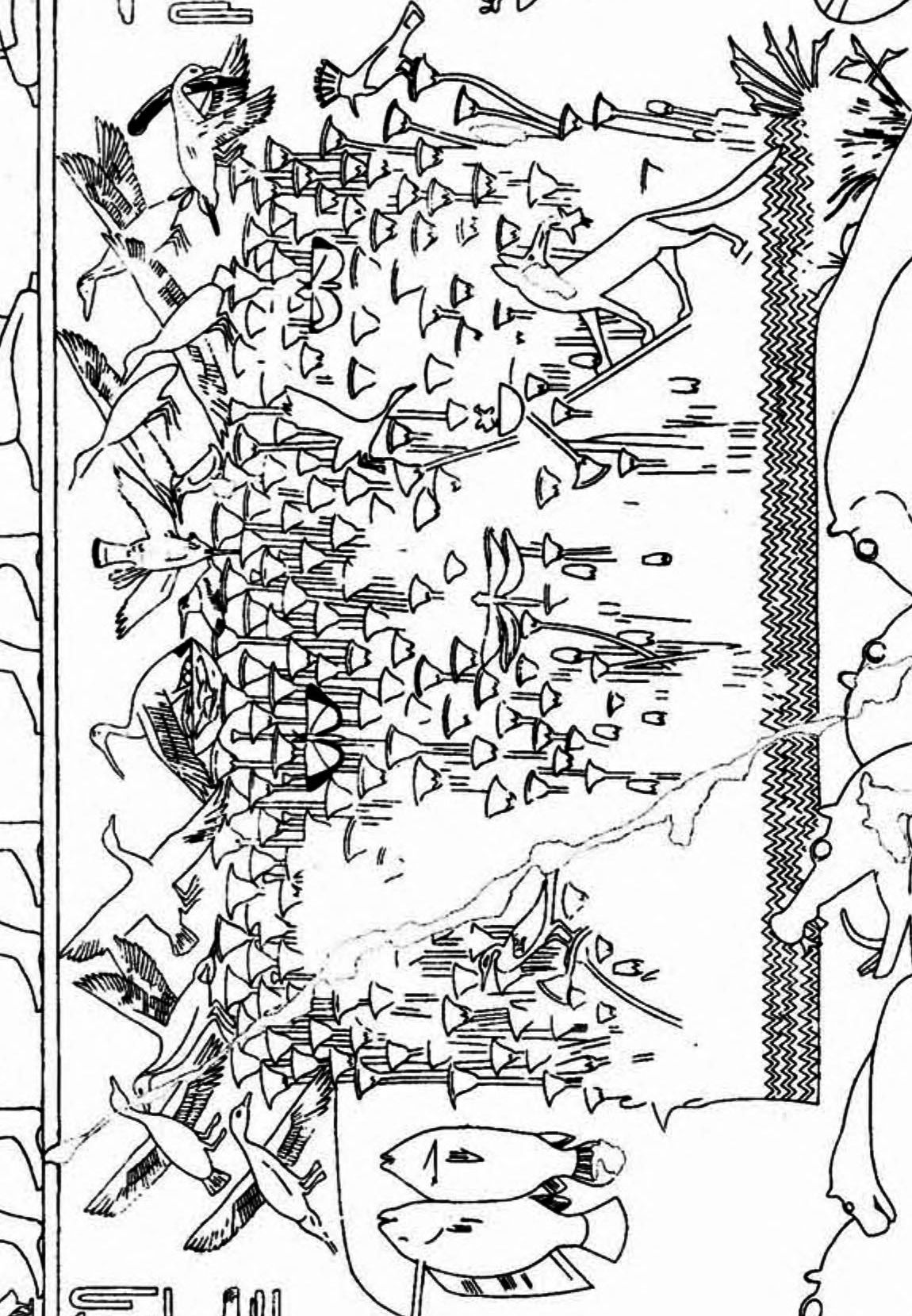
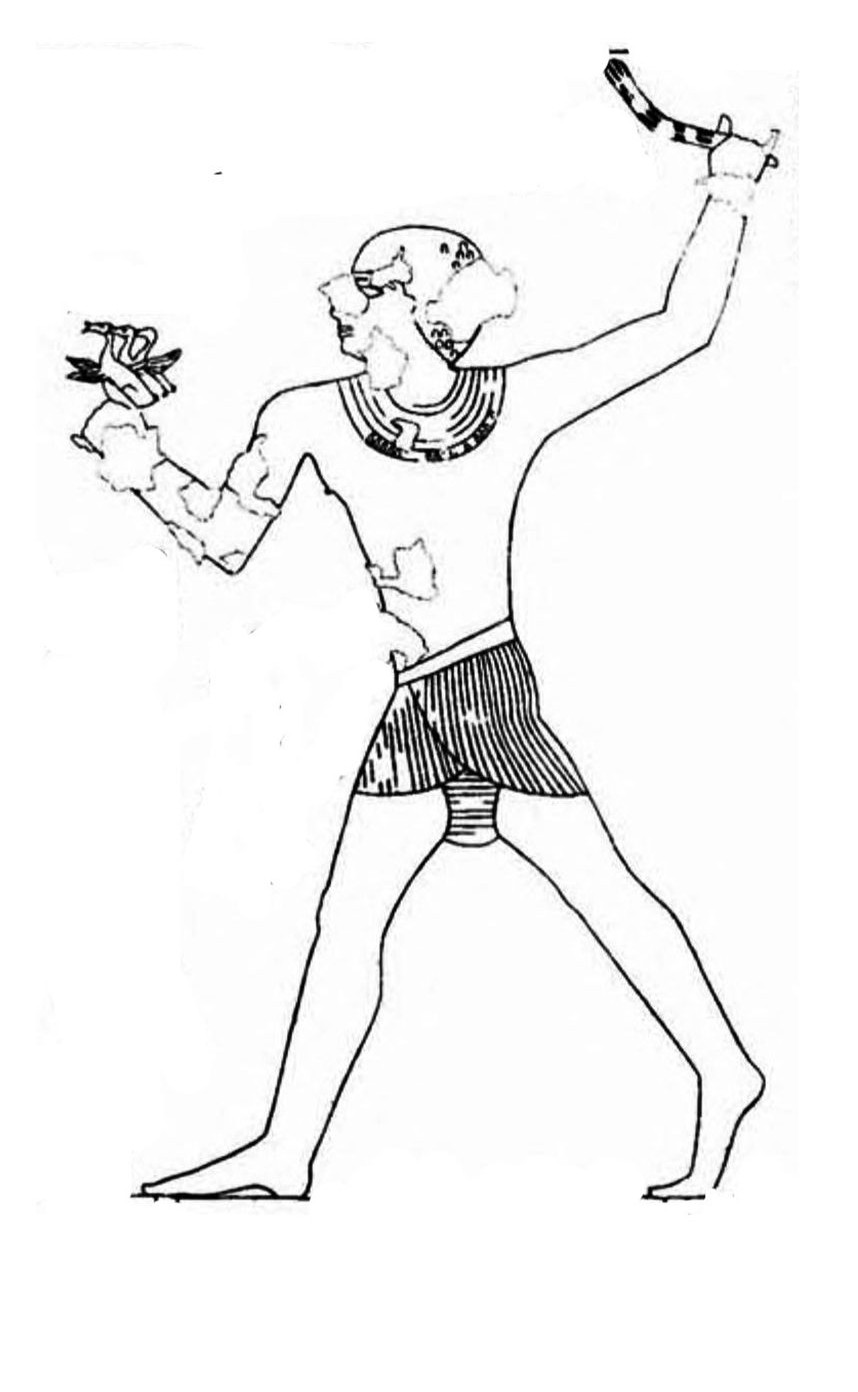
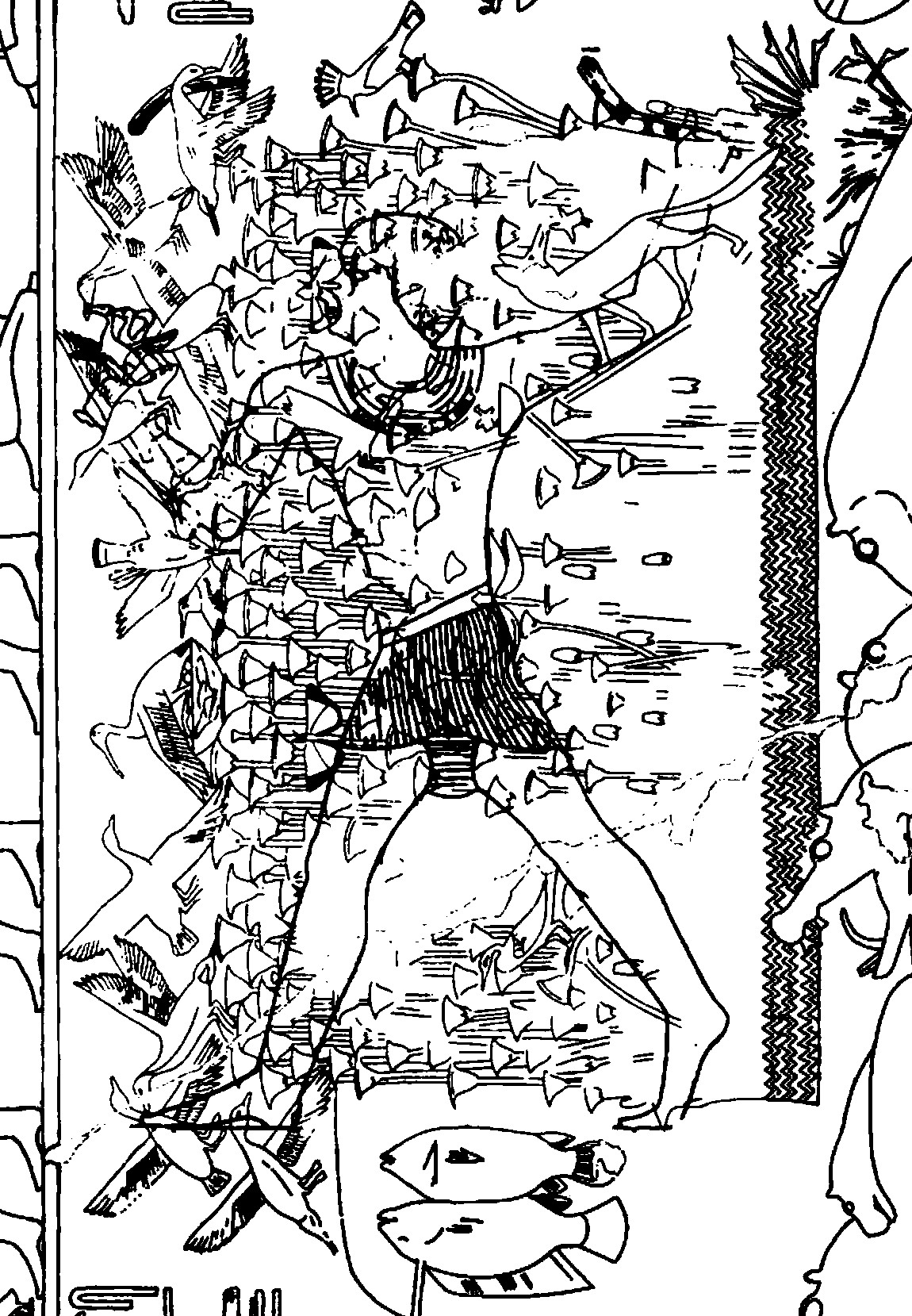
The doves of Giotto correspond to the birds in the hands of Senbi. 'Metronomen' would be the regularity of the drawings on the lower side of the 'baldachin' structure.
The hebrew parallel text to TEQ #835 is Genesis 19:30: ויעל לוט מצוער וישב בהר ושתי בנתיו עמו כי ירא לשבת בצוער וישב במערה הוא ושתי בנתיו
Genesis 19:30 - the hebrew text
I go through some of the meanings to the words - these can certainly with better equipment be more advanced - for showing that the 17 words apply to the 17 lines of the poem in somewhat relevant fashion if they apply in reverse order - the first hebrew word to the last line etc. Could be the forwards and backwards order should be plaited together - a la the flowgraph of a Fast Fourier Transform? Probably not as simple as that - but maybe some variant of some sort. This could anyhow suffice for showing the relevance for the theory of the white metre and the 'sunflower matrix':
ויעל = to go up, ascend, climb
לוט = envelope, covering
מצוער = insignificance
וישב = to sit, remain, dwell
בהר = mountain, hill, hill country
ושתי = two (a cardinal number)
בנתיו = daughter
עמו = with
כי = that, for, when
ירא = to fear
לשבת = to sit, remain, dwell -
שבת = to observe the Sabbath
בצוער = insignificance; boy, servant -
צועה = to lie down, banquet
וישב = to sit, remain, dwell -
ישו = Jesus (of Nazareth)
במערה = a cave -
מערכה = arrangement, order
הוא = he, she, it
ושתי = two (a cardinal number) -
שתי = lay foundation of, start loom
בנתיו = daughter
16 january 2024:
3.
Giotto's "Crucifixion" (source)

could be interpreted in light of TEQ #276
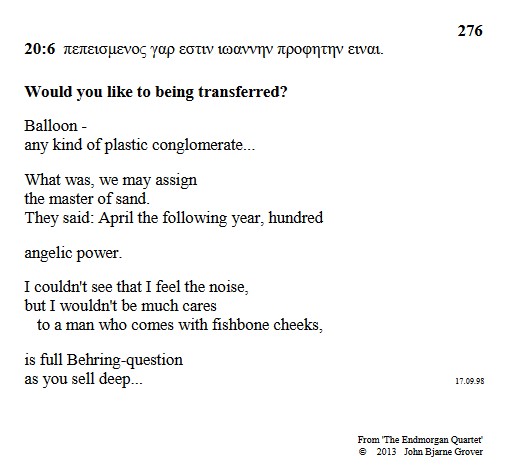
The parallel text is from Luke 20:6 (last six words)
Christ is about to be transferred to the other side of death and this is interpreted in the form of the mirror symmetries of the cross - in my poem 'april the following year'. The 'balloon' is likely to be his glory, the plastic conglomerate arises from the gravity. The poem seems to be symmetric after the title, with the horizontal and vertical beams of the cross in beginning and end and with the triad of people in the following three lines. The mysticism of the painting could apply to the idea of symmetries of the last border. The 'fishbone cheeks' of the lower man kissing his feet could even be recognized in the 'parallel text' on top - IC XC (for 'Jes-us Christ-us') as 1*100 + 10*100, or 100 with butterfly symmetries.
The poem TEQ #276 bis found also in comparison with 'Der Dornenstrauch' in this overview.
For studying this assumed 'other side' of the theme of Giotto's artwork, one can look up the mirror poem to #276 in TEQ which is TEQ #1444. Does this poem meet the greek parallel text of TEQ #276?
(Notice also the relevance of this poem #1444 for the second Giotto referred to above).
This poem TEQ #1444 has hebrew parallel text from Talmud Erubin: רישא לרב הונא בריה דרב יהושע לא קשיא
which I here look up word by word in Jastrow's dictionary (skipping the flats and sharps of grammar) for comparing with my poem TEQ #276 and with the artwork of Giotto:
רישא = head, drop (cp. glory, drooping head, dripping blood)
לרב
see רב = large, great, numerous, senior
הונא = Huna, proper conduct, imposition, redress in case of overreaching (cp. fishbone cheeks, imposing meaning on sign)
בריה = creature, human being, people, mankind
דרב see
דרבנ = iron point on the staff - here for 4th stigma - cp. 'master of sand', 'not much cares'
יהושע = Joshua - see
הושעה = relief, delivery
לא = NEGATION, no, not (cp. 'angelic')
קשיא = hard, strong, heavy, difficult (cp. 'power')
Conclusion: These complexities of my TEQ relative to Giotto could suffice for the theory that my TEQ is revelational poetry.
Sources:
Bassano: I maestri del colore, Fratelli Fabbri Editori, Milano.
Giotto: I maestri del colore #27, Fratelli Fabbri Editori, Milano 1964.
Grover, J.: The Endmorgan Quartet. Venice 2008, Vienna 2014.
Hahn (post Lachmannum et Tischendorfium): Novum Testamentum Graece, Lipsiae 1861.
Parmigianino: I maestri del colore #24, Fratelli Fabbri Editori, Milano 1963
Talmud Erubin, the classic Vilna edition, El Hamekoroth, Jerusalem 1947/48.
© John Bjarne Grover
On the web 14 january 2024
Last updated 17 january 2024